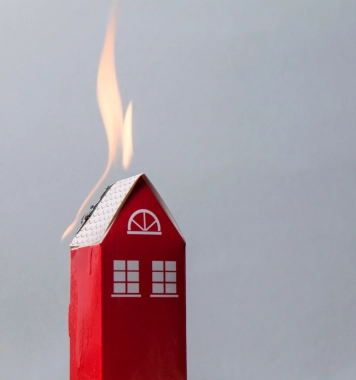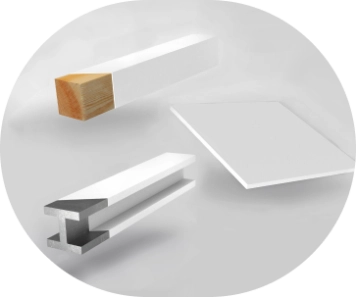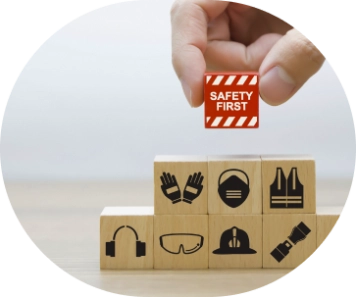One can’t oversell the importance of proper fire safety in an interior design. Architects are responsible for ensuring that the proper measures are taken as they design buildings with fire safety in mind. Of course, achieving the proper fire rating is not always a straightforward experience.
This article covers key aspects for architects to consider as they create fire safety designs:
- •What is fire safety design?
- •Fire safety building codes and regulations
- •Intumescent paint and fire safety design
- •FlameOFF Coatings solutions
- •Benefits of FlameOFF fire barrier paint
- ◦Use the same product for multiple substrates
- ◦Alternative solution to extra layers of drywall
- •Intumescent paint is time and cost-efficient
- •Lunch&Learn with FlameOFF
Design and fire safety are not mutually exclusive concepts; architects are responsible for incorporating escape routes, passive fire protection, and active fire protection features into their plans. The goal of any architect is to incorporate fire safety into a smooth and aesthetically pleasing design.
- Building layout
- The incorporation of fire-resistant materials in construction
- Easily accessible fire exits
- Fire detection
- Suppression systems
- Easy firefighter access
This is a multidisciplinary approach to architectural design and requires the expertise of various industry professionals to ensure that no facet of safety is sacrificed. However, attentiveness to all these features as well as building regulations is vital to creating and reducing the risk of fire hazards in building construction.
As if it wasn’t already complicated, getting bogged down by codes and regulations can be very challenging for architects struggling to implement a fire safety conscious design. One of the most tedious yet vital components of construction projects can be ensuring that all designs are up to standard.
Sometimes unanticipated challenges arise in overlooking building codes and regulations which can cause delays in a project as well as budgetary issues.
To avoid these mixups architects should be familiar with local building codes and regulations related to fire protection. These codes specify requirements for fire resistance ratings, sprinkler systems, alarms, and other fire safety measures.
Similarly, architects should strive to understand the fire resistance ratings of different building materials and components. This knowledge will help them select appropriate materials and design assemblies that can resist the spread of fire.
Architects are increasingly adopting intumescent paint as a revolutionary, efficient, and convenient solution for fire-safety designs.
In the case of a fire, a surface coated with intumescent paint will be protected from exposure to high temperatures. When activated by flames, the intumescent coating begins to char and expand, forming a protective insulating layer over the substrate which will limit property damage, fire spread, and facilitate more time for building occupants to escape.
Important considerations for architects regarding intumescent paint are as follows:
•Building Codes: As always it is critical for architects to keep local regulations related to fire protection in mind. There are codes pertaining to intumescent paint that specify the required fire resistance ratings for building materials and components.
•Application: Intumescent paints, like FlameOFF Fire Barrier Paint, can be applied to a variety of surfaces, including steel, wood, and gypsum to generate 1-2 hours of fire protection. However, architects and applicators should pay close attention to manufacturers’ instructions. This includes aspects like surface preparation and components such as wet and dry film thickness.
•Aesthetics: One of the main appeals of intumescent paint over other alternatives is the aesthetic advantage. Products such as Fire Barrier Paint offer a smooth latex like finish, allowing architects to incorporate fire protection into the building design without sacrificing aesthetics.

Understanding the benefits and limitations of intumescent paint can help architects make informed decisions about its application in fire safe building design.
FlameOFF Coatings is a leading manufacturer of state-of-the-art fire protective coatings, offering an innovative intumescent coating that has aided architects in obtaining the right fire rating across many projects.
Sometimes unanticipated challenges arise in overlooking building codes and regulations which can cause delays in a project as well as budgetary issues.
•Read more about our product listings
FlameOFF's smooth intumescent finish offers the advantage of compatibility across various substrates, so that only one product is needed to sufficiently protect a range of materials including, but not limited to, steel, drywall, and wood.
An intumescent paint that is compatible across a multitude of substrates grants flexibility and uniformity across a construction project. The paint's expansion and insulation properties will be consistent, regardless of the material it is applied to. This quality helps maintain the overall fire resistance of the building and reduces the risk of potential weak points in fire protection while keeping style homogenous across substrates.
The FlameOFF approach is more cost-effective and time efficient than that of competitors as only one product is required to apply proper fire safety to a design. Eliminate most of the hassle associated with selecting, procuring, and applying different coatings for different materials. Further, having a single product across substrates will simplify maintenance procedures going forward.
Oftentimes architects may attempt to meet the required fire rating in a project by adding additional layers of drywall. While this is an effective method to meet the right safety standards, it comes with certain constraints that may make intumescent coatings like FlameOFF Fire Barrier Paint the preferred approach.
Adding an extra layer of drywall to a wall or ceiling assembly may lead to alterations in room dimensions as it will add an amount of thickness to the preexisting structure. An extra layer of drywall will add weight to a structure, and further analysis might be required to ensure the building can handle the additional weight. Additionally, this method may require additional labor and loss of use if a building is already occupied. Not to mention- it makes a mess!
In contrast, the application of intumescent paint addresses these concerns without impacting the structural integrity of the building and operates as an easy lightweight, space-saving solution. Application is typically much quicker, with less clean up, which can result in less impact to existing building users.
Applying an intumescent coating requires significantly less construction work making it the least intrusive and most efficient approach to achieving the right fire rating on a building assembly.
FlameOFF Fire Barrier paint is easily accessible, and quick and straightforward to apply as compared to adding additional layers of drywall which may delay the progression of your construction project for days or weeks.
Similarly, this coating offers a great alternative in passive fire protection on steel structures. As a lightweight solution, it can be used on steel members where other solutions are incompatible due to weight restrictions.
Do you have questions about an upcoming project requiring a 2 hour fire rating? Contact FlameOFF Coatings technical sales support team for any inquiries!
FlameOFF Coatings offers an exclusive opportunity for architectural firms to attend a virtual lunch&learn presentation to discuss the intricacies of this innovative fire protection option.
Our flexible and private event allows your firm an opportunity to attend an informative presentation tailored toward architects, and to speak directly with the company president of FlameOFF Coatings and ask as many questions as you need, tailored to your company and current or upcoming projects.
